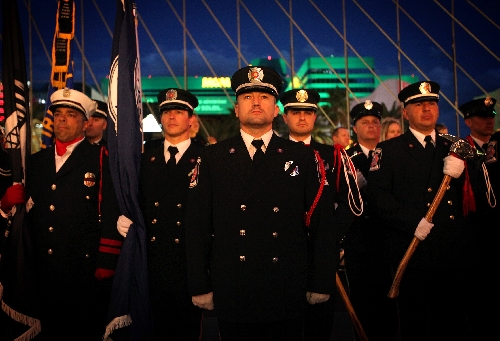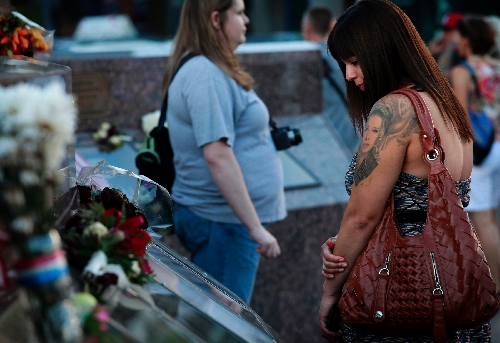Firefighters, visitors remember 9/11 at New York-New York


Sometimes, it is not the plans people make but the detours they find themselves taking that produce the profound moments in their lives.
The evidence is the crying young woman, the public monument, the somber parade, all at the New York-New York on Sunday. None of it was planned, but all of it happened.
Picture a 24-year-old woman, with dark hair and wearing a tank top, which shows off her tattoos. She is in town from Fontana, Calif., for the weekend, a trip she takes every now and then.
This is Tiffany Paniagua. She and a friend were driving along Sunday afternoon when they thought, hey, let’s go to M&M’s World on the Strip.
They headed over. They saw the New York-New York across the street. It was Sept. 11, 2011. It had been 10 years. People gathered.
Paniagua stopped at the memorial to the firefighters lost exactly 10 years ago. She paused to read a letter about a man named Michael Dermott Mullan, a firefighter who died then. His mother signed the letter.
And now Paniagua is crying. She had no idea this was going to happen.
She was 14 years old the day the towers fell, a high school freshman. She did not understand, then, what it meant. She did not understand why her school’s principal made such a big deal about it, did not understand why her mother was crying when she got home from school.
She understands it now.
“It is so terrible,” she says.
The words are inadequate, but her face says more.
For the last several hours, the last few days, the last 10 years, this keeps happening. Circumstances force themselves upon people. These circumstances create things — feelings, monuments, ceremonies, stories — that did not exist before.
It can hit like that, unexpectedly, without planning for it, without knowing why.
And that is the point of the monuments and the ceremonies. They create moments that make people feel things they might not have known they needed to feel.
The people crowd around this memorial outside the hotel. They read the T-shirts and the inscriptions. They leave flowers, pause to reflect, to take a snapshot.
They do not need a ceremony, or a monument, to help them remember a day no American alive back then will, or could, ever forget.
But the ceremonies are held anyway, the monuments are built, because they help. They connect people to one another through a common ritual, a shared experience in a specific space.
This site, a granite-entombed monument to the firefighters, was not built because somebody planned it. It was built because the sadness America felt in the days after the 9/11 attacks flat-out demanded it.
Mourners came here to the New York-New York because it made sense. They saw the faux Statue of Liberty and they looked upon the replica FDNY fireboat in the pretend harbor, and they wept.
They began to leave mementos almost immediately. Flowers and notes, stories and T-shirts.
First, it was one. Then another and another, and it built momentum like no planned project could. Soon, there were hundreds, thousands, of fire department T-shirts from around the world hanging on the iron spikes of the fence. Something had to be done with it all. The people had silently demanded it.
And so this memorial, this place to reflect, this impromptu monument to what the people had lost, and to what the people could be, sprang up.
The story behind the ceremony here Sunday night is almost identical, as these things tend to be.
Like any good story it seemed to happen by accident.
Mike Tomko is a Las Vegas firefighter. He’s big and loud and used to fight fires and rescue people in New York.
He says that in the days after 9/11, the local firefighters would sometimes come to the New York-New York.
On the one-year anniversary, maybe a dozen guys showed up. Word spread, as it does among people with a common interest. More came the next year, more the next, until it built into an event.
It is a parade now, with honor guards and bagpipes and full dress uniforms and a march across the miniature Brooklyn Bridge.
No media are ever invited. No politicians speak.
“It’s not so much remembering the day,” Tomko says, “but to remember what happened that day to the people. They got up, kissed their wives, went to work. And that was it.”
He says the whole thing is treated like a celebration, not a memorial. They joke about how their old buddies are up high somewhere, looking down on them as they tell stories in the casino’s Irish pub, Nine Fine Irishmen.
“It takes away the pain of the day,” he says, as much as anything can take away the pain.
And so the sun is setting now. A local couple in New York firefighter T-shirts stops at the memorial. They read virtually every line written on every inscription, look at the memorabilia, walk away in silence.
A young man has spray painted his dad’s old Army uniform gold. He’s painted his face, his hands. He is a mime, he says. He is honoring this day through art.
The crowd has grown now, to hundreds. The firefighters make their way to the bridge, fire trucks block the street, bagpipes are tested, onlookers snap photos, but they remain mostly silent.
The traffic hums by as life goes on, and the firefighters begin to march.
Contact reporter Richard Lake at rlake@reviewjournal.com or 702-383-0307.












